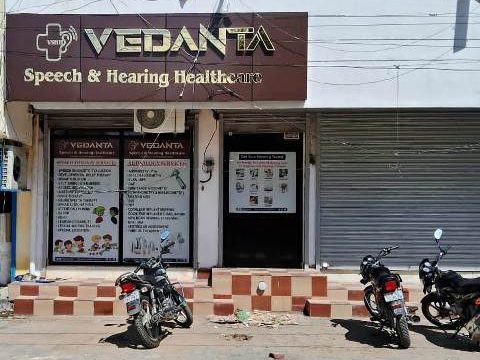Accurate tests to assess hearing and recommend care.
Helping children and adults speak clearly and confidently.
Digital hearing aids fitted for your lifestyle and hearing loss.
From evaluation to AVT, we’re with you at every step.
Advanced hearing implant solutions for better clarity.
Consult online from the comfort of your home.
Accurate tests to assess hearing and recommend care.
Helping children and adults speak clearly and confidently.
Digital hearing aids fitted for your lifestyle and hearing loss.
From evaluation to AVT, we’re with you at every step.
Advanced hearing implant solutions for better clarity.
Consult online from the comfort of your home.

Language disorders are communication disorders that involve difficulty understanding (receptive language), using (expressive language), or both understanding and using spoken, written, or other language systems. These difficulties go beyond what’s expected for a person’s age or development and can significantly impact academic, social, and daily functioning. (difficulty understanding or using language (the message itself) Speech Disorders: challenges in sound production (e.g., articulation, voice, fluency). Difficulty producing sounds (the way the message is said) Language Disorders: trouble with understanding others (receptive) or conveying ideas (expressive) Developmental Language Disorder (DLD) is a common subtype, where a child shows persistent language difficulties—both expressive and receptive—without other underlying conditions such as autism or hearing loss . Language disorders can significantly impact: Academic learning (reading, writing, comprehension) Social interaction (expressing emotions, building relationships) Overall self-confidence
Receptive Language Disorder Difficulty understanding language, Trouble following directions, Difficulty understanding questions or stories, Often responds inappropriately Expressive Language Disorder Difficulty expressing thoughts, ideas, or needs, Limited vocabulary, Struggles to form sentences, Uses incorrect grammar or word order Expressive Language Disorder Difficulty with both understanding and producing language.
In Children Late talking or limited vocabulary, Difficulty forming sentences or telling stories, Poor grammar for age, Difficulty understanding spoken instructions In Adults : Trouble finding words, Speaking in short or incomplete sentences, Difficulty following conversations, May result from brain injury (e.g., stroke, traumatic brain injury)
Developmental: Often identified in early childhood without a known cause (Specific Language Impairment – SLI) Neurological: Due to brain injury, stroke, or developmental disorders (e.g., autism) Genetic: Family history of language disorders Hearing loss, intellectual disability, or environmental factors

Fluency disorder is an interruption in the flow of speaking characterized by a typical rate, rhythm, and disfluencies (e.g., repetitions of sounds, syllables, words, and phrases, sound prolongations, and blocks), which may also be accompanied by excessive tension, speaking avoidance, struggle behaviors, and secondary mannerisms. And the dimensions of fluency suggested are: 1. The continuity or smoothness of speech 2. The rate of speech 3. The effort a speaker makes in producing speech and 4. Rhythm

Disturbances in the normal fluency and time patterning of speech that are inappropriate for the individual’s age and language skills, persist over time, and are characterized by frequent and marked occurrences of one (or more) of the following: (1) Sound and syllable repetitions; (2) Sound prolongations of consonants as well as vowels; (3) Broken words (e.g., pauses within a word); (4) Audible or silent blocking (filled or unfilled pauses in speech); (5) Circumlocutions (word substitutions to avoid problematic words); (6) Words produced with an excess of physical tension; (7) Monosyllabic whole-word repetitions (e.g., “I-I-I-I see him”).

Another fluency disorder is characterized by a perceived rapid and/or irregular speech rate, atypical pauses, maze behaviors, pragmatic issues, decreased awareness of fluency problems or moments of disfluency, excessive disfluencies, collapsing or omitting syllables, and language formulation issues, which result in breakdowns in speech clarity and/or fluency.
• Have pauses that are too short, too long, or improperly placed. • Does not sound “fluent,” that is, does not seem to be clear about what he or she wants to say or how to say it. • Sounds “jerky.” • Have excessive levels of “normal disfluencies,” such as interjections and revisions. • Has little or no apparent physical struggle in speaking. • Talks “too fast” based on an overall impression or actual syllable per minute counts. • Speech that is difficult to understand. • Auditory perceptual difficulties. • Confusing, disorganized language or conversational skills. • Limited awareness of his or her fluency and rate problems. • Temporary improvement when asked to “slow down” or “pay attention” to speech (or when being tape recorded). • Mispronunciation or slurring of speech sounds or deleting non-stressed syllables in longer words (e.g., “ferchly” for “fortunately”). • Several blood relatives who stutter or clutter. • Social or vocational problems resulting from cluttering symptoms. • Learning disability not related to reduced intelligence. • Sloppy handwriting. • Distractibility, hyperactivity, or a limited attention span.
Get a professional diagnosis from a speech-language therapist (or speech-language pathologist), like VEDANTA SPEECH AND HEARING HEALTHCARE. Speech therapy for fluency disorders may include working on the following in order to achieve fluent speech:
1. Reducing speaking rate
2. Self-awareness and self-monitoring
3. Fluency techniques similar to treatment for stuttering
4. Address any articulation (pronunciation) or language problems
5. Speech motor planning or coordination
Don’t Wonder If You Or Your Loved Ones Have Hearing Loss Or Speech Disorder; Find Out For Sure With Advanced Tests. Vedanta Speech And Hearing Healthcare Is Ready To Help You Or Your Loved One To Live Better. It All Starts With An Honest Conversation About Your Hearing Loss or Speech Disorder And a Test.

Vedanta Speech and Hearing Healthcare
# Number 6/1, MC Office Road, Punjabi Mohalla, Ambala Cantt # SCO 109, 1st Floor, Sector 40-C, Chandigarh Other Healthcare Centers also available at Ambala City, Chandigarh (Tricity), Jammu, Roorkee
91-7060360346 | +91-7347347718, Monday – Saturday | 10:00 am to 7:00 pm